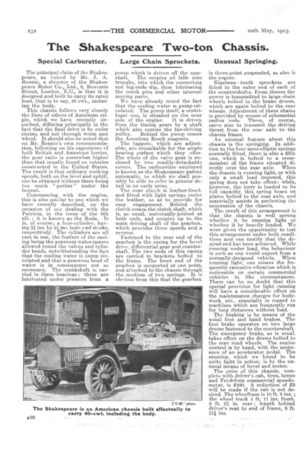The Shakespeare Two-ton Chassis.
Page 8

If you've noticed an error in this article please click here to report it so we can fix it.
Special Carburetter. Large Chain Sprockets. Unusual Springing.
The principal claim of the Shakespeare, as voiced by Mr. 3. A. -Rennie, a director of the Shakespeare Motor Co., Ltd., 6, Bouverie street, London, E.C., is that it is designed and built to carry its rated load, that is to say, 40 cwt., including the body.
This chassis follows very closely the lines of others of American origin, which we have recently described, differing principally in the fact that the final drive is by roiler chains, and not through worm and wheel. It should also be noted that on Mr. Rennie's own recommendation, following on his experience of both British and American lorries, the gear ratio is somewhat higher than that usually found on vehicles constructed in the United States. The result is that ordinary working speeds, both on the level and uphill, can be obtained without there being too much " pother " under the bonnet.
Commencing with the engine, this is also similar to one which we have recently described, on the occasion of our dealing with the Patricia, in the issue of the 8th ult. ; it is known as the Buda. It is, of course, a four-cylinder, having n ins. by 54, ins, bore end sti eke, respectively. The cylinders are all cast in one, the feature of the casting being the generous water spaces allowed round the valves and cylinder heads, notwithstanding the fact that the cooling water is pump eir'ciliated and that a generous head or water is in consequence not so necessary. The crankshaft is carried.in three hearings; these are lubricated under pressure from a
pump which is driven off the cam shaft. The surplus oil falls into troughs, into which the connecting rod big-ends dip, thus lubricating the crank pins and other internal moving parts.
We have already noted the fact that the cooling water is pump-circulated. The pump itself, a centrifugal one, is situated on the near side of the engine. It is driven from the timing gears by a shaft which also carries the fan-driving pulley. Behind the pump comes the American Bosch magneto.
The tappets, which are adjustable,. are remarkable for the ample bearing surface which they offer. The whole of the valve gear is enclosed by two readily-detachable covers. The carburetter employed is known as the Shakespeare patent automatic, to which we shall possibly be able to refer in greater detail in an early issue, The cone clutch is leather-lined, and fitted with light springs under the leather, so aS to provide for easy engagement. Behind the clutch comes the clutch shaft, which is, as usual; universally-jointed at both ends, and couples up to the main driving shaft of the gearbox, which provides three speeds and a reverse.
Fastened to the rear end of the gearbox is the casing for the bevel drive, differential gear and countershaft. The two ends of this casing are carried in brackets bolted to the frame. The front end of the gearbox is supported at one point, and attached to the chassis through the medium of two springs. It is obvious from this that the gearbox is three-point suspended, as also is the engine.
Nineteen tooth sprockets are fitted to the outer end of each of the countershafts. From thence the power is transmitted to large chain wheels bolted to the brake drums, which are again bolted to the rear wheels. Adjustment of these chains is provided by means of substantial radius rods. These, of course, serve also to transmit the driving thrust from the rear axle to the chassis frame.
An unusual feature about this chassis is the springing. In addition to the four semi-elliptic springs normally fitted, there is also a fifth one, which is bolted to a crossmember of the frame situated directly over the rear axle. When the chassis is running light, or with only a small load imposed, this spring does not take effect: when, however, the lorry is loaded to its full capacity, this spring bears on plates bolted to the rear axle, and materially assists in perfecting the suspension qf the chassis.
The result of this arrangement is that the chassis is well sprung whether it be running light or whether it be heavily loaded. We were given the opportunity to test this arrangement under both conditions and can testify that the desired end has been achieved. While running under load, the behaviour is such as one would expect from a normally-designed vehicle. When running light, one misses the frequently excessive vibration which is noticeable on certain commercial vehicles in like circumstances. There can he no doubt that this special provision for light running will have a considerable effect on the maintenance, charges for bodywork, etc., especially in regard to machines which are frequently run for long distances without load.
The braking is by means of the usual foot and hand brakes. The foot brake operates on two large drums fastened to the countershaft. The emergency brake, as is usual, takes effect on the drums bolted to the rear road wheels. The engine control is by hand, with the assistance of an accelerator pedal. The steering, which we found to be quite light in action, is by the unusual means of bevel and sector. .
The price of this chassis, complete with driver's cab, tires, lamps and Frocisham commercial speedometer, is £420. A reduction of £5 will be made if the cab is not desired. The wheelbase is 10 ft. 8 ins. ; the wheel track 4 ft. 11 ins. front. 5 ft. cq in. rear ; length behind driver's seat to end of frame, 9 ft. 111






















